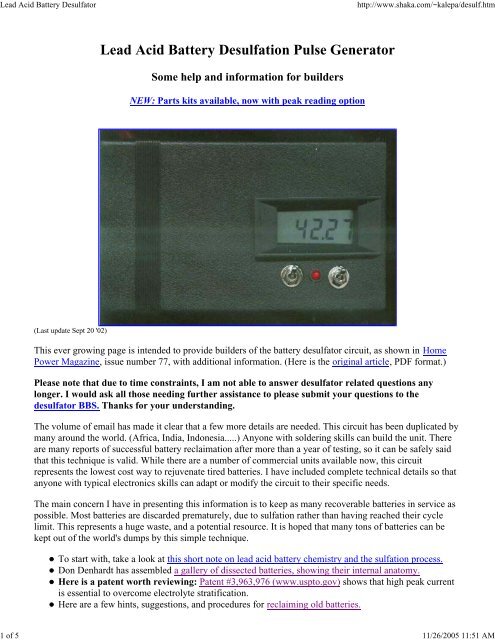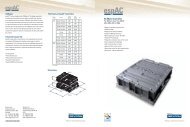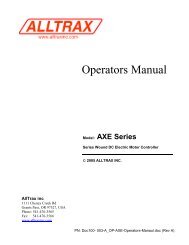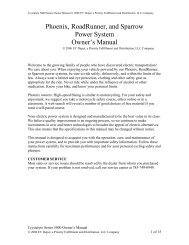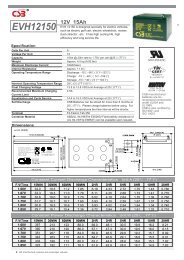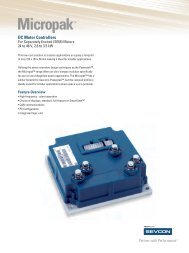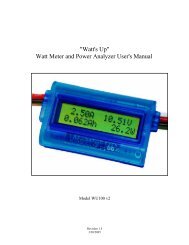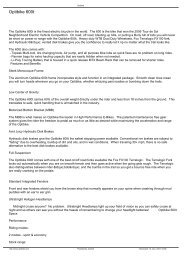Lead Acid Battery Desulfator - V is for Voltage electric vehicle forum
Lead Acid Battery Desulfator - V is for Voltage electric vehicle forum
Lead Acid Battery Desulfator - V is for Voltage electric vehicle forum
You also want an ePaper? Increase the reach of your titles
YUMPU automatically turns print PDFs into web optimized ePapers that Google loves.
<strong>Lead</strong> <strong>Acid</strong> <strong>Battery</strong> <strong>Desulfator</strong>http://www.shaka.com/~kalepa/desulf.htm1 of 5 11/26/2005 11:51 AM<strong>Lead</strong> <strong>Acid</strong> <strong>Battery</strong> Desulfation Pulse GeneratorSome help and in<strong>for</strong>mation <strong>for</strong> buildersNEW: Parts kits available, now with peak reading option(Last update Sept 20 '02)Th<strong>is</strong> ever growing page <strong>is</strong> intended to provide builders of the battery desulfator circuit, as shown in HomePower Magazine, <strong>is</strong>sue number 77, with additional in<strong>for</strong>mation. (Here <strong>is</strong> the original article, PDF <strong>for</strong>mat.)Please note that due to time constraints, I am not able to answer desulfator related questions anylonger. I would ask all those needing further ass<strong>is</strong>tance to please submit your questions to thedesulfator BBS. Thanks <strong>for</strong> your understanding.The volume of email has made it clear that a few more details are needed. Th<strong>is</strong> circuit has been duplicated bymany around the world. (Africa, India, Indonesia.....) Anyone with soldering skills can build the unit. Thereare many reports of successful battery reclaimation after more than a year of testing, so it can be safely saidthat th<strong>is</strong> technique <strong>is</strong> valid. While there are a number of commercial units available now, th<strong>is</strong> circuitrepresents the lowest cost way to rejuvenate tired batteries. I have included complete technical details so thatanyone with typical electronics skills can adapt or modify the circuit to their specific needs.The main concern I have in presenting th<strong>is</strong> in<strong>for</strong>mation <strong>is</strong> to keep as many recoverable batteries in service aspossible. Most batteries are d<strong>is</strong>carded prematurely, due to sulfation rather than having reached their cyclelimit. Th<strong>is</strong> represents a huge waste, and a potential resource. It <strong>is</strong> hoped that many tons of batteries can bekept out of the world's dumps by th<strong>is</strong> simple technique.To start with, take a look at th<strong>is</strong> short note on lead acid battery chem<strong>is</strong>try and the sulfation process.Don Denhardt has assembled a gallery of d<strong>is</strong>sected batteries, showing their internal anatomy.Here <strong>is</strong> a patent worth reviewing: Patent #3,963,976 (www.uspto.gov) shows that high peak current<strong>is</strong> essential to overcome electrolyte stratification.Here are a few hints, suggestions, and procedures <strong>for</strong> reclaiming old batteries.
<strong>Lead</strong> <strong>Acid</strong> <strong>Battery</strong> <strong>Desulfator</strong>http://www.shaka.com/~kalepa/desulf.htm2 of 5 11/26/2005 11:51 AMThere are now several versions available, tailored to specific needs:The original,low powerversion,suitable <strong>for</strong>most solarsystems,<strong>vehicle</strong>startermaintenance,andgradualbatteryreclaimation.There areseveralflavors of th<strong>is</strong>circuit.The highpowerversion,<strong>for</strong> largebatteryreclaimation,<strong>electric</strong><strong>vehicle</strong>maintenance,high voltagesystems, andlow levelcharging.Underdevelopment.The following provides some supplemental info and links <strong>for</strong> those interested intheoretical aspects and additional help:A few words about the "several megahertz resonance" that <strong>is</strong> mentioned in the original article. One of the
<strong>Lead</strong> <strong>Acid</strong> <strong>Battery</strong> <strong>Desulfator</strong>http://www.shaka.com/~kalepa/desulf.htm3 of 5 11/26/2005 11:51 AMmost frequent questions <strong>is</strong> about the fact that the drive frequency <strong>is</strong> at 1 khz, but the resulting vibrations inthe battery are at several MHz. Go back over the part in the article about the "plucked string". Th<strong>is</strong> <strong>is</strong> a verycommon situation in all systems with a resonant frequency. A d<strong>is</strong>turbance of any sort will tend to createvibrations at the resonance. The megahertz range vibrations are over very quickly, ie they are a dampedoscillation. The pulser circuit does not drive these frequencies, any more than a finger nail drives a guitarstring at its pitch.One can see them readily using an oscill<strong>is</strong>cope, but some care <strong>is</strong> required to get the triggering just right. Abetter way to see the fact that batteries have a high frequency resonance <strong>is</strong> to use a sweep generator, as in thediagram:In the original article, I put <strong>for</strong>th an idea of what might be happening in the battery to cause th<strong>is</strong> resonantfrequency, and guessed that it was occuring in the electrolyte itself. An email from battery expert HeinzWenzl, in Germany, said th<strong>is</strong>:The next question in my quest to understand th<strong>is</strong> <strong>is</strong> the following: Given the same battery typethere are small deviations of resonant frequency which are no measurement artefact. Now undernormal conditions (i.e. the battery not being deep-deep d<strong>is</strong>charged with an acid density close toone), there are always a lot of hydrogen and sulfate ions around which can create a plasma typecharge d<strong>is</strong>tribution. A change of the frequency could be linked to the electrolyte density which <strong>is</strong>related to the state-of-charge (I have found no real correlation here), the v<strong>is</strong>cosity (th<strong>is</strong> I wouldimagine would be linked to the IR spectrum of molecular vibrations), the current exchangedensity (linked to state-of-charge and surface area and catalytic properties, etc.) and to .... someothers. But gut feeling would tell me, that all these effects should be small compared to theplasma properties themselves. In which case, all lead acid batteries with flooded electrolyteshould have the same resonance and NiCd a different one.What makes you think that the plasma condition <strong>is</strong> associated with the electrolyte and not withthe solid material? Some lead minerals, e.g. PZT are piezo<strong>electric</strong> and the few Mhz are really inthat range of effects!So my original guess about what may be going on was not very close to the mark. Nevertheless, theresonance <strong>is</strong> very much there, and it helps to create conditions of high peak voltage (ringing) that arefavorable to the process of desulfation.Does th<strong>is</strong> really work ?The results are coming in. Here are some typical comments:
<strong>Lead</strong> <strong>Acid</strong> <strong>Battery</strong> <strong>Desulfator</strong>http://www.shaka.com/~kalepa/desulf.htm4 of 5 11/26/2005 11:51 AMHello Alastair, I would like to thank you <strong>for</strong> such a neat product. I have reclaimed several batteriesnow that were junk. I have gathered up as many more as I can find and have them connected to an Air403 <strong>for</strong> charging and running of the desulfator. Free batteries and free power, doesn't get much betterthan th<strong>is</strong>. I have built several other desulfators <strong>for</strong> other people to use ..... thanks again <strong>for</strong> such afantastic project. Ed Goddard Castle Dale, Utah.I am pleased with the per<strong>for</strong>mance. Yours works faster than the $90 Pulse Tech unit I've had 3 years.George Ficklen Newport News, Va.I can actually see etching into the sulfate crystals on top of the cells. Eric Wiggins. Thames, N.Z.It looks as though th<strong>is</strong> little device saved me $60.00. The white deposits have all but d<strong>is</strong>appeared onthe plates. Scott S<strong>is</strong>son. Portland, Or.A number of comments on the message board have been about battery testing. Here <strong>is</strong> a response fromGeoge Aumann:Using a res<strong>is</strong>itive load to measure battery condition <strong>is</strong> a standard method. For each battery typea standard load <strong>is</strong> defined, and if the voltage under load drops below a certain level, the battery<strong>is</strong> bad or in need of recharging. For small batteries th<strong>is</strong> load can be typical, like a 5 Ohm load<strong>for</strong> a AA Alkaline drops the voltage at end-of-life to 1.0 Volts. Using a load across the battery(<strong>for</strong> a few mill<strong>is</strong>econds) <strong>is</strong> used by laptop computers to assess the charge status of the battery.For big batteries the "standard" load res<strong>is</strong>tor may get to be very small. However, given theavailbility of good and fairly cheap(under $40) 3 1/2 digit digital volt meters, it <strong>is</strong> not necessary(or safe) to draw a big current spike out of the battery to measure its internal impedance. For myDynasty UPS12-310 High output battery I use a 1 Ohm 1% 20 watt res<strong>is</strong>tor shunted with a bardirectly to the battery terminals. The resulting drop across the 1 Ohm res<strong>is</strong>tor <strong>is</strong> eazy to measurewith the voltmeter set to the 200 mV scale.A fully charged 12.6 volt lead-acid battery will have an internal res<strong>is</strong>tance of about 0.01 ohms.My Dynasty UPS12-310 high output battery <strong>is</strong> spec'd at 0.0033 Ohm. Determine the internalres<strong>is</strong>tance of the battery by measuring the terminal voltage with open circuit, V, and then thevoltage drop across an accurately known res<strong>is</strong>tive load R, voltage DV. The internal impedanceof the battery, Ri, <strong>is</strong> then given by Ri= DV * R / V.Example: V=12.60 volts and DV= 81 mV Volt using a 1 Ohm 1% 20 watt Ohmite res<strong>is</strong>tor. Ri=0.081* 1.0 / 12.6 = 0.0064 Ohm.The power d<strong>is</strong>sipated in the res<strong>is</strong>itor <strong>is</strong> V*V / R = 12.52 * 12.52 = 158 watt. The res<strong>is</strong>tor will getwarm very quicky. If th<strong>is</strong> experiment <strong>is</strong> not fin<strong>is</strong>hed quickly, the temperature increase willchange the res<strong>is</strong>tance. Th<strong>is</strong> will make the measurement inaccurate and will burn your fingers).Somebody on the email suggested pulling 200A, presumably using a 0.062 Ohm res<strong>is</strong>tor. Pullingthat much power (200 * 12.6 = 2.5KW!) has to be done fast indeed. Batteries of th<strong>is</strong> size can bevery dangerous.If you would like to communicate with others in th<strong>is</strong> project, or to ask questions not answered by the abovematerial, please try thedesulfator bulletin board.Some relevant links:Commercial <strong>Desulfator</strong>s from Solar-Electric.comTechnical details on why pulse charging <strong>is</strong> good.
<strong>Lead</strong> <strong>Acid</strong> <strong>Battery</strong> <strong>Desulfator</strong>http://www.shaka.com/~kalepa/desulf.htm5 of 5 11/26/2005 11:51 AMTh<strong>is</strong> shows that Ni Cads are similarly benefittedHere <strong>is</strong> an email exchange on battery testing techniques.A <strong>Battery</strong> Tester by Meggerhttp://www.btechinc.com/ Another battery tester.http://www.powerdesigners.com/InfoWeb/design_center/Appnotes_Archive/A2615.shtm Further <strong>Battery</strong>testing info.http://www.batterybes.com/ Commercial desulfator.http://www.innovativeenergy.com/index.htm Another commercial desulfator.http://www.van-haandel-1.myweb.nl/Download.html An article in Dutch about a desulfator with someinteresting features. See page 2 <strong>for</strong> the schematic. Here <strong>is</strong> a translation to Engl<strong>is</strong>h of the most importantdetails.http://users.pandora.be/vandenberghe.jef/battery/Back to Aquarian HomepageV<strong>is</strong>itors since April 2, 2002:


